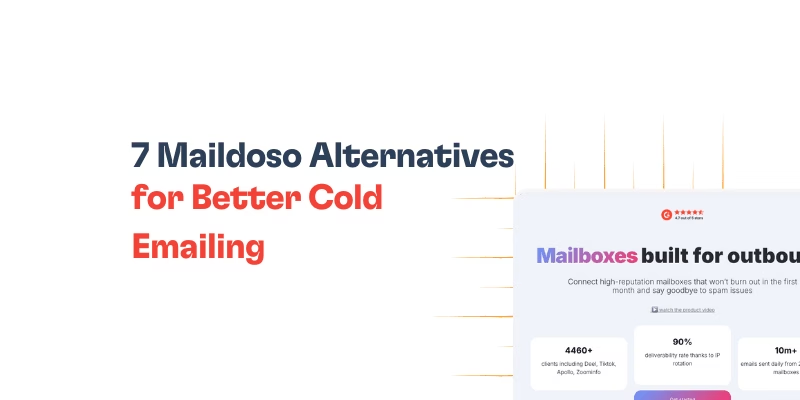Email success is not just about sending emails. It’s also about ensuring your emails land in inboxes.
After all, even the most well-written email will not drive results if it gets filtered to spam. Here’s where Warmy.io’s free Inbox Placement Test comes in.
This tool helps you understand exactly how your emails are performing across different email providers, identify potential issues, and take actionable steps to improve deliverability.
Let’s walk through how it works and why it’s essential for your email success.
What is an inbox placement test?
An Inbox Placement Test is a diagnostic tool that reveals where your emails are landing, whether in the main inbox, promotions tab, spam, or if they don’t get delivered at all.
This test simulates real-world sending conditions and helps you:
Evaluate sender reputation, domain health, bounce rates, and spam risks, which impact whether emails reach recipients.
Measure inbox placement across providers like Gmail, Outlook, Yahoo, and more
- Detect technical issues with email authentication like SPF, DKIM, and DMARC, which are critical for ensuring messages are recognized as legitimate.
- Identify other potential issues affecting your email deliverability
Why inbox placement testing matters
Deliverability and inbox placement go hand in hand, but they’re not exactly the same thing.
Email deliverability measures whether your message successfully reaches the recipient’s mail server.
Inbox placement determines where exactly it lands — inbox, spam, or another folder.
Both are critical for your campaigns’ success. Without testing, you’re sending emails blindly, not really knowing how many emails actually reach your audience.
How to use Warmy.io’s Inbox Placement Test
Using Warmy’s free test is simple and takes just a few minutes. Follow these steps to check your inbox placement:
1. Access the tool
Head over to Warmy’s Free Email Deliverability Test page to take the inbox placement test.
2. Take the test
- You will be asked to select if you’re sending via an email account, a marketing system, or API request.
- You will then see a list of test email addresses.
- Choose your preferred address format (line breaks, commas, etc.).
- Click Copy to copy the list.
3. Send the test email to the list
Open your email platform and create a new message.
Paste the copied addresses into the To field.
Add your subject line and message content. For more accurate results, use your real campaign email.
Hit Send.
4. Check your results within 3-5 minutes.
Go back to the Warmy.io page and click Check Email Deliverability.
- In just 3-5 minutes, Warmy will generate a detailed report that includes:
- Inbox placement percentages or how many emails landed in the inbox, spam, or promotions tab across Gmail, Outlook, and Yahoo.
- Delivery failures or emails that were blocked or not delivered.
- Information if your domain or IP address appears on any major email blacklists.
Take the next step to improve inbox placement
Testing your emails is the first step toward achieving reliable deliverability. While our free email deliverability test provides essential insights, Warmy.io offers a full suite of advanced tools to elevate your email performance:
AI-powered warmup: Gradually enhance your sender reputation through automated warm-up campaigns that simulate natural interactions.
Domain Health Monitoring: The comprehensive Domain Health Hub tracks domain’s performance in real time and provides metrics on inbox placement, blacklist status, DNS records, and more, all in one easy-to-use dashboard.
Authentication Setup: Warmy’s free SPF and DMARC generators ensure your domain’s emails are properly authenticated.
Template Checker: The template checker scans your email content for potential spam triggers, formatting issues, or subject line errors before hitting send. The Chrome Extension also lets you perform real-time checks while drafting your emails.
Advanced Seed Lists: Test with real, engaged email addresses to ensure your warm-up interactions reflect genuine engagement, not simulated activity.
Ready to take charge of your email deliverability? Start with Warmy’s free email deliverability test today and gain actionable insights to improve your campaigns while safeguarding your sender reputation.
FAQ
How often should I conduct an inbox placement test?
Inbox placement tests are crucial to ensure that your emails are reaching your recipients' inboxes and not being flagged as spam or junk.
It's recommended to conduct an inbox placement test:
- Before launching a significant email campaign.
- Whenever you make significant changes to your email content or design.
- At regular intervals, such as quarterly, to ensure consistent deliverability.
Why are my emails landing in the spam folder even after passing the spam test?
Even if your emails pass spam tests, several factors can cause them to land in the spam folder:
- Sender Reputation: If your sending IP or domain has a poor reputation, ISPs might flag your emails as spam.
- Engagement Rates: Low open and click-through rates can signal to ISPs that recipients are not interested in your emails.
- Complaint Rates: If a high number of recipients mark your emails as spam, ISPs will take note.
- Authentication Issues: Ensure that you have set up SPF, DKIM, and DMARC correctly.
- Content and Design: Certain words, phrases, or design elements can trigger spam filters.
Can I improve deliverability rates overnight?
Improving email deliverability rates is a process and often can't be achieved overnight. However, some immediate actions can help:
- Ensure your email lists are clean and free from invalid or outdated addresses.
- Segment your audience and send relevant content.
- Avoid spammy words or phrases in your content.
- Ensure proper email authentication with SPF, DKIM, and DMARC.
- Monitor feedback loops and address any complaints promptly.
Remember, building a good sender reputation takes time and consistent effort.
Are there any legal implications for emails marked as spam?
Yes, there are legal implications for sending unsolicited emails or emails that are frequently marked as spam. Laws like the CAN-SPAM Act in the U.S., GDPR in Europe, and CASL in Canada set strict guidelines for commercial emails.












